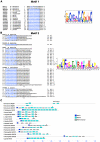A MAP6-related protein is present in protozoa and is involved in flagellum motility
- PMID: 22355359
- PMCID: PMC3280300
- DOI: 10.1371/journal.pone.0031344
A MAP6-related protein is present in protozoa and is involved in flagellum motility
Abstract
In vertebrates the microtubule-associated proteins MAP6 and MAP6d1 stabilize cold-resistant microtubules. Cilia and flagella have cold-stable microtubules but MAP6 proteins have not been identified in these organelles. Here, we describe TbSAXO as the first MAP6-related protein to be identified in a protozoan, Trypanosoma brucei. Using a heterologous expression system, we show that TbSAXO is a microtubule stabilizing protein. Furthermore we identify the domains of the protein responsible for microtubule binding and stabilizing and show that they share homologies with the microtubule-stabilizing Mn domains of the MAP6 proteins. We demonstrate, in the flagellated parasite, that TbSAXO is an axonemal protein that plays a role in flagellum motility. Lastly we provide evidence that TbSAXO belongs to a group of MAP6-related proteins (SAXO proteins) present only in ciliated or flagellated organisms ranging from protozoa to mammals. We discuss the potential roles of the SAXO proteins in cilia and flagella function.
Conflict of interest statement
Figures






Similar articles
-
Human FAM154A (SAXO1) is a microtubule-stabilizing protein specific to cilia and related structures.J Cell Sci. 2015 Apr 1;128(7):1294-307. doi: 10.1242/jcs.155143. Epub 2015 Feb 11. J Cell Sci. 2015. PMID: 25673876
-
CMF22 is a broadly conserved axonemal protein and is required for propulsive motility in Trypanosoma brucei.Eukaryot Cell. 2013 Sep;12(9):1202-13. doi: 10.1128/EC.00068-13. Epub 2013 Jul 12. Eukaryot Cell. 2013. PMID: 23851336 Free PMC article.
-
The Parkin co-regulated gene product, PACRG, is an evolutionarily conserved axonemal protein that functions in outer-doublet microtubule morphogenesis.J Cell Sci. 2005 Dec 1;118(Pt 23):5421-30. doi: 10.1242/jcs.02659. Epub 2005 Nov 8. J Cell Sci. 2005. PMID: 16278296
-
Parasites in motion: flagellum-driven cell motility in African trypanosomes.Curr Opin Microbiol. 2010 Aug;13(4):459-65. doi: 10.1016/j.mib.2010.05.015. Epub 2010 Jun 28. Curr Opin Microbiol. 2010. PMID: 20591724 Free PMC article. Review.
-
[The flagellum: from cell motility to morphogenesis].J Soc Biol. 2003;197(4):379-87. J Soc Biol. 2003. PMID: 15005520 Review. French.
Cited by
-
Cytoplasmic preassembly of the flagellar outer dynein arm complex in Trypanosoma brucei.Mol Biol Cell. 2024 Sep 1;35(9):br16. doi: 10.1091/mbc.E24-06-0263. Epub 2024 Jul 18. Mol Biol Cell. 2024. PMID: 39024276 Free PMC article.
-
Control of assembly of extra-axonemal structures: the paraflagellar rod of trypanosomes.J Cell Sci. 2020 May 27;133(10):jcs242271. doi: 10.1242/jcs.242271. J Cell Sci. 2020. PMID: 32295845 Free PMC article.
-
Cryo-EM structure of cortical microtubules from human parasite Toxoplasma gondii identifies their microtubule inner proteins.Nat Commun. 2021 May 24;12(1):3065. doi: 10.1038/s41467-021-23351-1. Nat Commun. 2021. PMID: 34031406 Free PMC article.
-
Cilium transition zone proteome reveals compartmentalization and differential dynamics of ciliopathy complexes.Proc Natl Acad Sci U S A. 2016 Aug 30;113(35):E5135-43. doi: 10.1073/pnas.1604258113. Epub 2016 Aug 12. Proc Natl Acad Sci U S A. 2016. PMID: 27519801 Free PMC article.
-
Redistribution of FLAgellar Member 8 during the trypanosome life cycle: Consequences for cell fate prediction.Cell Microbiol. 2021 Sep;23(9):e13347. doi: 10.1111/cmi.13347. Epub 2021 May 14. Cell Microbiol. 2021. PMID: 33896083 Free PMC article.
References
-
- Amos LA, Schlieper D. Microtubules and maps. Adv Protein Chem. 2005;71:257–298. - PubMed
-
- Bosc C, Andrieux A, Job D. STOP proteins. Biochemistry. 2003;42:12125–12132. - PubMed
-
- Brinkley BR, Cartwright J., Jr Cold-labile and cold-stable microtubules in the mitotic spindle of mammalian cells. Ann N Y Acad Sci. 1975;253:428–439. - PubMed
-
- Gory-Faure S, Windscheid V, Bosc C, Peris L, Proietto D, et al. STOP-like protein 21 is a novel member of the STOP family, revealing a Golgi localization of STOP proteins. J Biol Chem. 2006;281:28387–28396. - PubMed
Publication types
MeSH terms
Substances
LinkOut - more resources
Full Text Sources
Molecular Biology Databases

